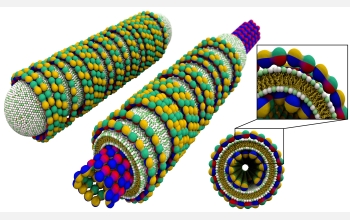Multimedia Gallery
An up-close look at the new "smart" bio-nanotubes.
This is an up-close look at "smart" bio-nanotubes. Lipid protein nanotubes are made of microtuble protein (with the tubulin protein subunits shown as red-blue-yellow-green objects) that is coated by a lipid bilayer (drawn with yellow tails and green and white spherical heads.) The bilayer, in turn, is coated by tubulin protein rings or spirals. By controlling the relative amount of lipid and protein it is possible to switch between two states of nanotubes with either open ends (shown in the center) or closed ends with lipid caps (shown on the left), a process which forms the basis for controlled chemical and drug encapsulation and release. A top view of the nanotubes and a magnified region is shown on the right.
Credit: Peter Allen, University of California, Santa Barbara
Images credited to the National Science Foundation, a federal agency, are in the public domain. The images were created by employees of the United States Government as part of their official duties or prepared by contractors as "works for hire" for NSF. You may freely use NSF-credited images and, at your discretion, credit NSF with a "Courtesy: National Science Foundation" notation.
Additional information about general usage can be found in Conditions.
Also Available:
Download the high-resolution JPG version of the image. (3.7 MB)
Use your mouse to right-click (Mac users may need to Ctrl-click) the link above and choose the option that will save the file or target to your computer.
Related story: A "Smart" Bio-Nanotube



